
- All Instrument Types
- Indices
- Equities
- ETFs
- Funds
- Commodities
- Currencies
- Crypto
- Bonds
- Certificates
Please try another search

Norges Bank Paving the Way for the Riksbank?

On Wednesday, Norges Bank surprised the market by cutting the Folio rate by 50 basis points. In a note sent out yesterday, we illustrated some of the similarities between the countries. In some sense the economic situation in Sweden is softer than that in Norway – for instance in the labour market, bank lending and house prices. Wider fixing spreads (thoroughly discussed in this publication recently) have come into the spotlight in domestic press in recent days. We note a growing debate about the European crisis having repercussions for Sweden and mortgage borrowers in terms of higher lending rates, despite a more downbeat outlook for the domestic economy. The market reaction after Norges Bank’s cut suggests higher probability for a 50bp cut (currently 31bp next week in prices) and liquidity facilities. It remains to be seen if this will be the outcome, but liquidity is becoming cheaper as we write.
We are determined to keep our long-term strategy for a steeper bond curve with a twist. The twist is being long 2y mortgage bonds at the front against 10y government bonds at the long-end.
Just to refresh our memory, we have gone through how the curve moved when the Rikbank started to cut and introduce different liquidity facilities (Swedish krona and US dollar) in 2008. The government bond curve steepened by some 260bp during the nine months between October 2008 to June 2009. The interest rate level is something completely different this time, so we will not come near such a hefty move. Just like now, the rate cuts and liquidity measures were supportive for credit spreads. Hence, the curve 10y government vs 2y mortgage bonds (generic rates) moved by 370bp during the same time period (the same curve, but with 2y swaps at the front, moved “only” 340bp). Note that this calculation is in generic rates so if taking roll-down into account the move was
certainly even bigger. So, we like 2y mortgage bonds vs 10y govies and see a potential of some 50-70bp. The curve (generic) 10y/2y govies vs mortgage bonds is currently at minus 43bp.
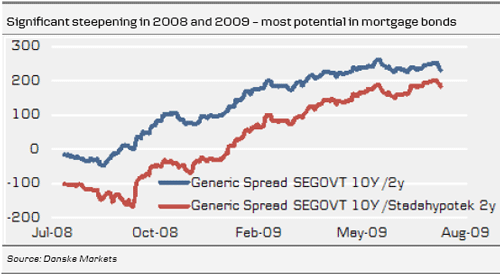
The short-end of the government bond curve is not far from fully-priced in terms of cuts. RIBA contracts imply cuts equal to some 125bp over the next 12 months. However, note that SGB1041 is trading dear in the repo market, so it should be trading more expensively – i.e. implying more than 125bp. Rate cuts, together with liquidity measures (or if liquidity gets cheaper anyway) will support credit spreads more than outright rate slides in government bonds. So hold on to steepeners with mortgage bonds at the front. Last week we discussed a way to hedge that position with a TED spread – buying the FRAJUN12 against selling RIBASEP12 – in a TED spread widener. Now when liquidity is getting much cheaper we see an alternative way to play the TEDs. The TED curve (FRA over RIBAs) is heavily negatively sloped.
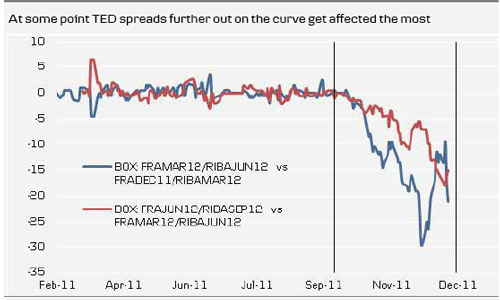
We believe liquidity could either become less stressed – tightening the front TEDs the most – or either stress will move further out in longer TED spreads. At some point more stress will hit the second spread than the front spread. This is what has happened with the current front contract FRADEC11 vs RIBAMAR12 (see chart). Now the FRAMAR12 vs RIBAJUN12 becomes the front TED, but that spread is already at an elevated level compared with the “spot” spread, which is at 114bp (current 3MSTIBOR fixing over the implied average repo rate over the next three months, at 91bp), whereas the FRAJUN12 vs RIBASEP12 TED spread is trading at 76bp. So the TED box FRAMAR12/RIBAJUN12 against FRAJUN12/RIBASEP12 looks interesting. If more stress hits the market the longer spread will eventually widen more than the front, resulting in spreads moving closer to each other. If, on the other hand, liquidity becomes cheaper (via Riksbank measures or via more favourable FX forwards when creating Swedish krona from EURIBOR or USD LIBOR) the front spread will ease more than the longer spread – resulting again in spreads closer to each other. If the Riksbank offers liquidity facilities the box would likely move toward zero.
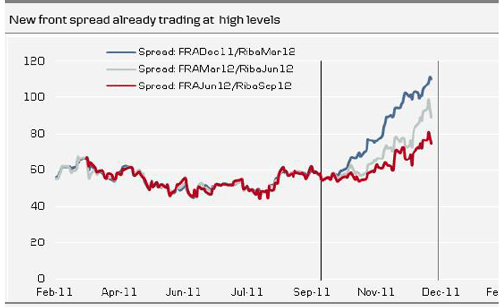
Cut rates!
The reasons behind Norges Bank’s decision to cut rates by 50bp should be taken into serious consideration by the Riksbank. Of course, the fundamental reason is that the outlook for Norway’s economy is deteriorating. On top of that, however, Norges Bank underlines that the ongoing financial turmoil in Europe is pushing up funding costs for Norwegian banks as well – potentially tightening financial conditions for consumers and businesses. This is no doubt also the case in Sweden, which, as we have stressed earlier, is part of the reason why for instance short-rate mortgage loans are getting more expensive.
But there is another very important component to consider – the labour market. We are getting more early signals that labour market conditions in Sweden are already worsening. “Already” in the sense that the labour market typically turns later in the economic cycle.
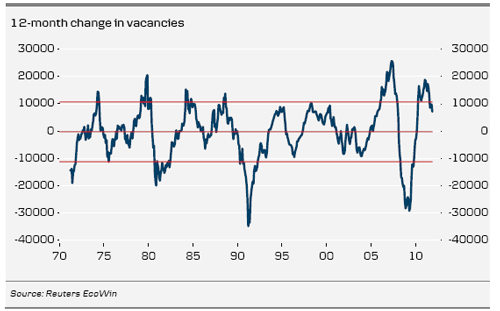
Vacancies appear to be slowing down and filled vacancies (people actually getting a job) are declining. Employment and unemployment rates seem to be levelling out. Even more important, lay-offs have started to rise and that is definitely something to keep an eye on during the coming months. There has been a pretty clear upward trend in lay-offs over the past three months and we are now approaching levels that typically trigger higher unemployment within a few months. If the Riksbank subscribes to this analysis the simple conclusion is to ease rates. Historically, there has been a very close connection between unemployment and monetary policy, which is illustrated in the following chart
(OBS reverse scale for the repo rate).
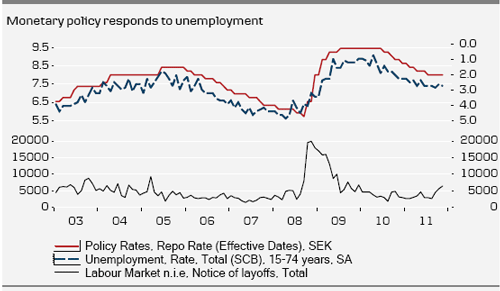
In our view, it would be very difficult to understand why the Riksbank wouldn’t act if it sees a worsening labour market ahead. Inflation can’t possibly be a restriction. In practice there is a potential problem, if we are getting into a situation in which unemployment is on the rise when the repo rate is quite low from the outset. To be specific, higher mortgage rates – mainly due to earlier repo rate hikes – accounts for 62% of the current CPI inflation rate (2.9%). The latest Riksbank inflation forecast covers 39 months (to December 2014), under which CPIF inflation reaches 2% from below only during the past six months. To put it differently, inflation is expected to undershoot for 85% of the forecast horizon. We don’t expect the Riksbank to revise the forecast up. If on top of that the labour market (resource utilisation) starts to weaken the policy conclusion
is clear. In fact, it would even be a potentially serious policy mistake to wait.
According to theory, when unemployment starts to rise and rates are low from the outset the central bank should act more promptly (rapid cuts) to avoid the risk of hitting the zero-bound restriction before policy is affected. That risk is of course greater if the transmission mechanism is hampered by financial market stress – such is the case in the euro area and also in Sweden. But historical experience suggests that the Riksbank is unlikely to act more aggressively, at least for now and that is why we believe that a 25bp cut is the likely result of next week’s policy announcement. But we recommend keeping an eye on money market rates. If for instance if 3M Stibor fails to respond to a rate cut we would expect the Riksbank to inject liquidity in the banking sector by offering repo facilities in a similar fashion as in 2008.
Related Articles

Back in late December, I showed gold stock investors some key cycle and oscillator charts for XAU/USD and the miners, suggested that the GDX (NYSE:GDX) ETF and its component...

The central bank’s job is never easier, but in the current climate, it’s unusually tricky. In addition to the usual challenges that complicate real-time monetary policy decisions,...

At age 94, Warren Buffett can still formulate a shareholder letter like no other. His humility, candor, and wisdom is special. I always make it a point to read these because you...
Are you sure you want to block %USER_NAME%?
By doing so, you and %USER_NAME% will not be able to see any of each other's Investing.com's posts.
%USER_NAME% was successfully added to your Block List
Since you’ve just unblocked this person, you must wait 48 hours before renewing the block.
I feel that this comment is:
Thank You!
Your report has been sent to our moderators for review





Add a Comment
We encourage you to use comments to engage with other users, share your perspective and ask questions of authors and each other. However, in order to maintain the high level of discourse we’ve all come to value and expect, please keep the following criteria in mind:
Enrich the conversation, don’t trash it.
Stay focused and on track. Only post material that’s relevant to the topic being discussed.
Be respectful. Even negative opinions can be framed positively and diplomatically. Avoid profanity, slander or personal attacks directed at an author or another user. Racism, sexism and other forms of discrimination will not be tolerated.
Perpetrators of spam or abuse will be deleted from the site and prohibited from future registration at Investing.com’s discretion.